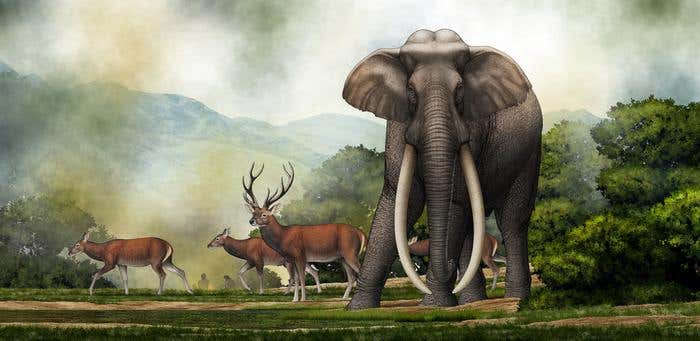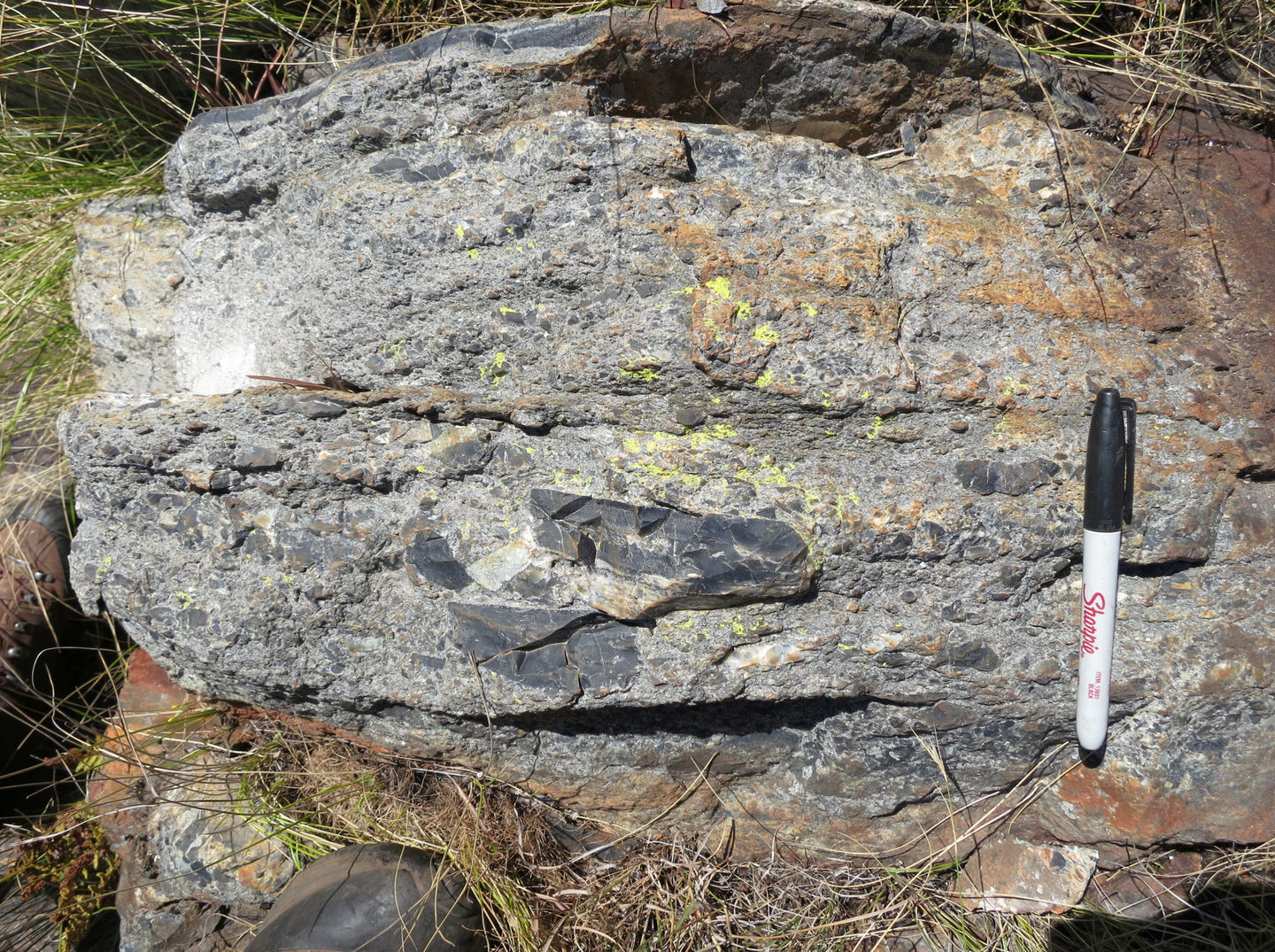Massive fossilized elephant skull belongs to prehistoric species
A fossilized Palaeoloxodon skull from Kashmir sheds light on elephant evolution and human interaction during the Middle Pleistocene.

The discovery of a prehistoric elephant skull in Kashmir unveils evolutionary mysteries and human connections to megafauna during the Middle Pleistocene. (CREDIT: Chen Yu)
A fossilized elephant skull discovered in northern India’s Kashmir Valley offers a rare glimpse into the evolutionary history of one of Earth’s most impressive megafauna.
This remarkable find, unearthed in 2000 and published in the journal, Vertebrate Paleontology, reveals significant insights into the biology and dispersal of Palaeoloxodon, a genus of straight-tusked elephants that once roamed across Africa, Europe, and Asia.
The skull, unearthed from the Karewa sediments of the Pampore Member, was accompanied by 87 stone tools, hinting at its coexistence with prehistoric humans. Found in the Karewas—ancient fluvio-lacustrine deposits of the Kashmir Valley—the fossil represents one of the best-preserved Palaeoloxodon specimens from the Indian subcontinent.
Its discovery has spurred international research, bringing together scientists from institutions such as the Florida Museum of Natural History, the British Museum, and the Natural History Museum in London.
The skull exhibits a mix of primitive and advanced features characteristic of Palaeoloxodon. While its broad, flat forehead resembles later Eurasian species, it lacks the prominent parieto-occipital crest typically seen in other members of the genus. This crest, a thickened projection on the skull’s roof, usually becomes more pronounced with age and sexual maturity in male elephants.
Dr. Steven Zhang, a palaeontologist at the University of Helsinki, noted, “From the size, the wisdom teeth, and other features of the skull, it is evident this was a majestic bull elephant in the prime of its life. Yet, the underdeveloped crest suggests a distinct species.”
These observations align the Kashmir skull most closely with Palaeoloxodon turkmenicus, an enigmatic species described from a single skull found in Turkmenistan in the 1950s.
For decades, scientists debated whether the Turkmen skull represented a separate species or an aberrant individual of the well-documented European Palaeoloxodon antiquus. However, the discovery of the Kashmir specimen bolsters the case for P. turkmenicus as a distinct species with a broad range across Central Asia and the northern Indian subcontinent.
Related Stories
The Karewas, where the fossil was discovered, are sedimentary formations nestled within the intermontane basin of the Kashmir Valley. These layers date back to the Plio-Pleistocene, offering a window into ecosystems that thrived millions of years ago.
The Pampore Member, which yielded the skull, consists of laminated sands, clays, and silts. This formation is part of the upper Karewa Group, known for its rich fossil deposits.
Fossil evidence suggests that Palaeoloxodon originated in Africa around one million years ago before dispersing into Eurasia. Early African forms exhibited a narrow, convex forehead and minimal crest development. Over time, more derived species in Europe and Asia developed wide, flat foreheads and prominent skull crests. The Kashmir skull’s intermediate features provide crucial data for understanding the evolutionary trajectory of these massive elephants.
Dr. Advait Jukar, a lead researcher at the Florida Museum of Natural History, explained, “With its wide, flat forehead and faint trace of a crest, P. turkmenicus may represent a missing link in the evolutionary history of Palaeoloxodon. This species bridges the gap between primitive African ancestors and the more advanced Eurasian forms.”
The 87 stone tools discovered alongside the Kashmir skull hint at interactions between early humans and these prehistoric giants. These tools, likely used for butchering or other purposes, provide indirect evidence of human activity in the region during the Middle Pleistocene. This period, dating back 300,000 to 400,000 years ago, aligns with the estimated age of the skull based on protein decomposition in its tooth enamel.
The association of the tools with the fossil emphasizes the ecological and cultural significance of Palaeoloxodon. These elephants likely played a vital role in the lives of early humans, serving as sources of food, tools, and even inspiration for early art and storytelling. The co-occurrence of these artifacts and remains underscores the interconnectedness of species in prehistoric ecosystems.
Despite their size and prominence in ancient landscapes, much about Palaeoloxodon remains unknown. Fossil evidence from the Karewas and surrounding regions has been sparse compared to the more extensively studied Siwalik Hills to the south. The Kashmir skull, along with the Turkmen specimen, provides rare insights into the diversity and distribution of these extinct megaherbivores.
Researchers suggest that P. turkmenicus represents a transitional species. Its features bridge primitive African Palaeoloxodon recki and advanced Eurasian forms like P. antiquus. By combining morphological studies with advanced techniques such as protein decomposition analysis, scientists are piecing together the puzzle of this genus’s evolution.
Dr. Zhang highlighted the broader implications of the findings, stating, “These discoveries not only enrich our understanding of Palaeoloxodon but also illuminate the ecological and evolutionary pressures that shaped life in the Pleistocene.”
The Kashmir Palaeoloxodon skull stands as a testament to the intricate web of life that once flourished in the intermontane valleys of the Himalayas. Its discovery has reignited interest in the region’s fossil record, inspiring new studies on the Karewa sediments and their rich history.
As scientists continue to explore the evolutionary journey of these prehistoric giants, the Kashmir skull reminds us of the delicate balance of ecosystems past and present. This fossil is more than just a relic; it is a bridge connecting us to a time when Earth’s landscapes were dominated by creatures of extraordinary size and complexity.
Note: Materials provided above by The Brighter Side of News. Content may be edited for style and length.
Like these kind of feel good stories? Get The Brighter Side of News' newsletter.
Rebecca Shavit
Science & Technology Journalist | Innovation Storyteller
Based in Los Angeles, Rebecca Shavit is a dedicated science and technology journalist who writes for The Brighter Side of News, an online publication committed to highlighting positive and transformative stories from around the world. With a passion for uncovering groundbreaking discoveries and innovations, she brings to light the scientific advancements shaping a better future. Her reporting spans a wide range of topics, from cutting-edge medical breakthroughs and artificial intelligence to green technology and space exploration. With a keen ability to translate complex concepts into engaging and accessible stories, she makes science and innovation relatable to a broad audience.



